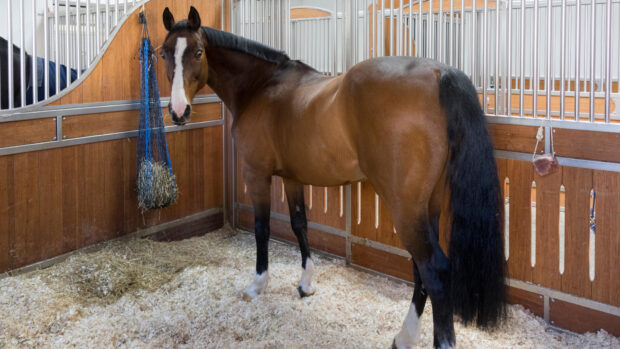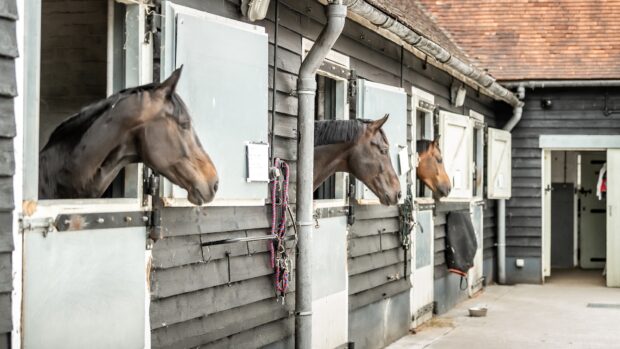Understanding how horses learn may be beneficial in preventing vets sustaining injuries when dealing with “difficult” horses, research has suggested.
A study, Difficult horses – prevalence, approaches to management of and understanding of how they develop by equine veterinarians, by researchers of the Royal (Dick) School of Veterinary Studies, University of Edinburgh, aimed to document the challenges faced by vets when dealing with difficult horses and their approaches to managing them, including their understanding of the processes through which horses learn.
Participants completed a survey and of 168 responses, 95% reported working with difficult horses on at least a monthly basis. Some 579 injuries were recorded in the past five years, of which 37% resulted in continued discomfort or loss of function. The most common unwanted behaviours were horses being bargy, not standing, or being needle-shy – but these were encountered less frequently by vets who had more years of experience. The most popular methods of dealing with unwanted behaviour were physical or chemical restraint, with 99% of respondents considering sedation very or fairly useful. Some 84% of respondents said they understood the term positive reinforcement, but when tested on what this meant, only 19% were correct. Of the 80% who said they understood negative reinforcement, 33% were correct when tested on its meaning.
Veterinary behaviourist and lead author Gemma Pearson, who has also published research on whether educational intervention can be used to help students become better at dealing with difficult horses, told H&H it was concerning how dangerous being an equine vet can be – and how frequently they were coming across difficult horses.
“These are injuries being caused by horse behaviour – whether they’ve been kicked or struck – and yet nobody teaches vets about horse behaviour. It’s assumed they’ll pick it up,” she said.
“It’s perhaps unsurprising that a lot of vets felt they understood equine behaviour really well because they spend a lot of time working with horses, but when we actually tested them on it, their knowledge of the processes through which horses learn were really poor. It’s disappointing, but probably not surprising. I’ve dealt with lots of vets who say ‘the horse is needle-shy and it’s just stubborn’ but they’re negatively reinforcing the behaviour, and actually we can reinforce an alternative behaviour.”
Ms Pearson runs courses for vets on practical learning theory and, in 2018, launched videos as part of the British Equine Veterinary Association’s (BEVA) Don’t Break Your Vet Campaign including a video showing how to inject a horse safely using positive reinforcement with clicker training and food. This year, for the first time, vet students studying at the University of Edinburgh will have lectures on learning theory and horse behaviour.
Lucy Grieve, chair of the BEVA ethics and welfare committee, told H&H the study demonstrates a potential problem “across the board” when it comes to horse behaviour.
“Everyone has their opinions on how to handle difficult horses, but with so much anecdote, and simply ‘doing what one has always done’, there has been little time spent trying to understand if there is a better, safer way,” she said.
“The more we can understand what people are doing, how well those things work, what effect it has on the horse short- and long-term, and whether it reduces the risk of injury, the better.”
Ms Grieve added that teaching and sharing up-to-date knowledge and proven methods is essential for learning and to help avoid horses suffering needlessly, and people getting hurt unnecessarily.
“As a practising vet on the road, often with little help when things get hairy, I have suffered my own injuries and been lucky to walk away from some pretty terrifying situations. But since I adopted the methods Gemma has been promoting, such as those featured in the BEVA Don’t Break Your Vet campaign, I can say they really work. I have several needle-shy horses which nearly hospitalised people and forced vets to abandon procedures due to fear of safety. Thanks to Gemma’s techniques based on how horses learn, these horses are now happily injected with no fear or danger in sight. This has to be the way forward. Safety is paramount in every case, but the methods used need to be sustainable and ethical.”
World Horse Welfare chief executive Roly Owers told H&H the charity is encouraged to see this type of research being undertaken as equine mental health and the safety of vets, and other paraprofessionals, are “hugely important issues that warrant much closer attention”.
“Too often, if an equine displays ‘unwanted’ behaviour, it is described as behaving badly or being difficult. But there is usually an underlying reason for displaying this behaviour, such as being confused or in pain,” he said.
“It is deeply concerning that so many vets are injured by horses they are trying to help, and it is unsurprising that the most popular method of dealing with these ‘difficult’ horses is physical or chemical restraint. The problem is this treats the symptom and not the cause, and using physical restraint might make the horse even more difficult to control the next time.”
Mr Owers added that while people are “generally good” at evaluating the physical welfare of horses, understanding their mental welfare is still “relatively novel”, although it is just as important.
“The use of learning theory – understanding how horses take in and process the world around them – and how we can use this knowledge to effectively and compassionately train horses – is crucial to promoting better handling and training methods,” he said. “There is a great opportunity for the veterinary profession to champion this type of approach as a way of not only protecting themselves but also promoting improved equine mental wellbeing. Many owners are not aware about learning theory and how to incorporate it into their daily handling and training and vets are perfectly placed to help to fill this gap.”
You might also be interested in:

Hat hair, don’t care: vets urged to wear helmets for many equine procedures
“Head injuries are sadly a high risk for vets and nurses in practices and they occur in all sorts of

Horse owners urged: ‘don’t break your vet’!
Equine vets have a higher risk of being injured at work than firefighters

Subscribe to Horse & Hound magazine today – and enjoy unlimited website access all year round
Horse & Hound magazine, out every Thursday, is packed with all the latest news and reports, as well as interviews, specials, nostalgia, vet and training advice. Find how you can enjoy the magazine delivered to your door every week, plus options to upgrade your subscription to access our online service that brings you breaking news and reports as well as other benefits.




